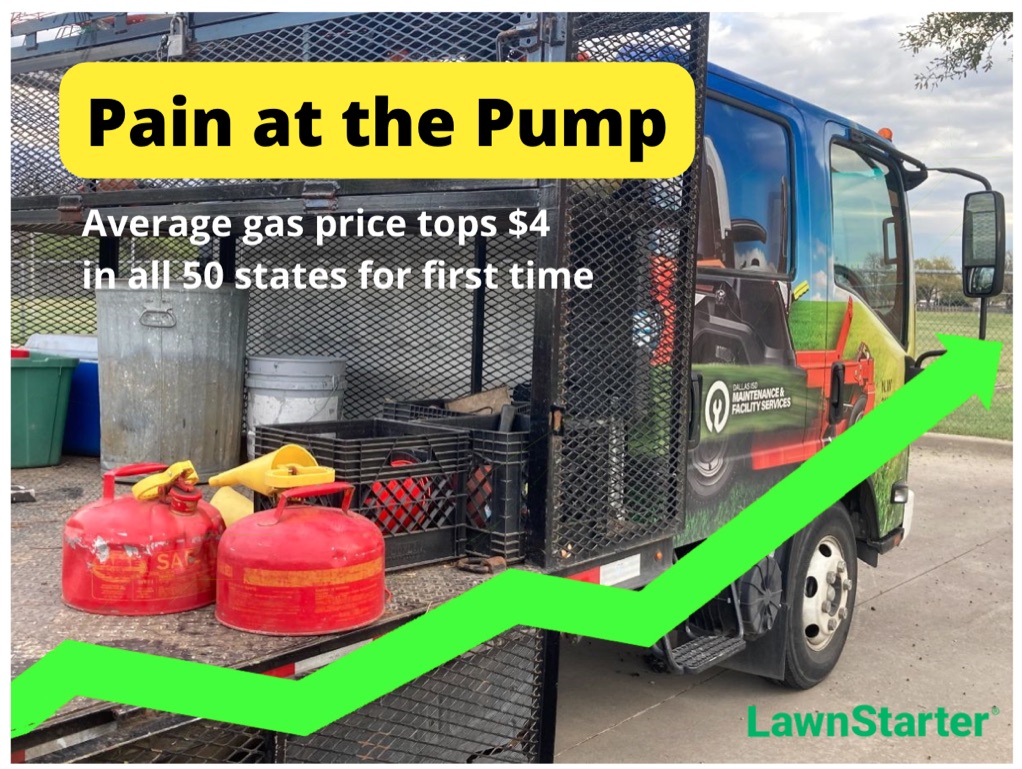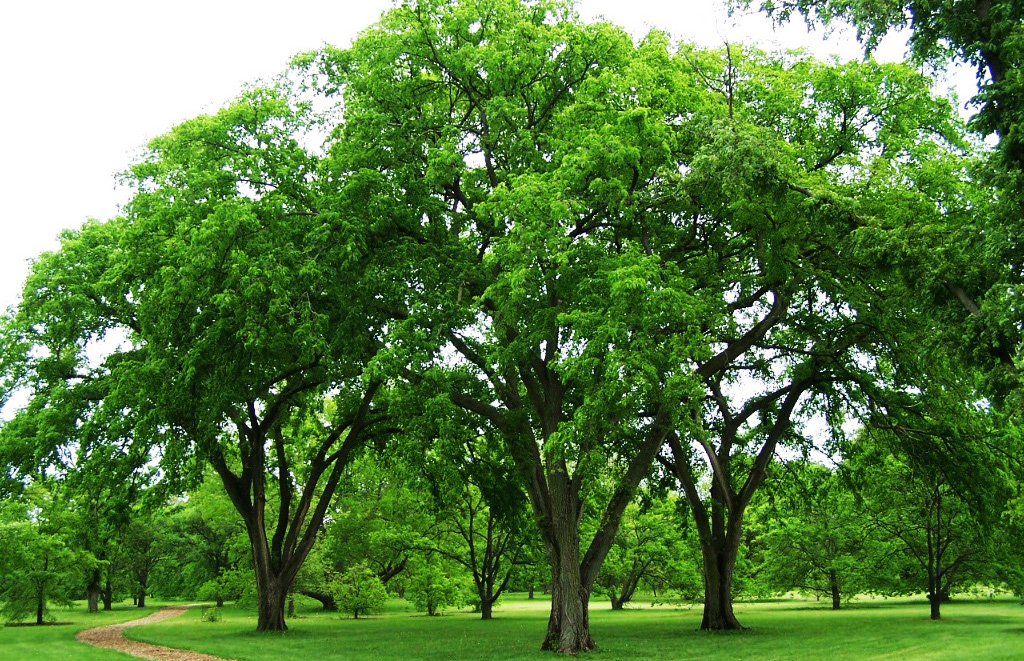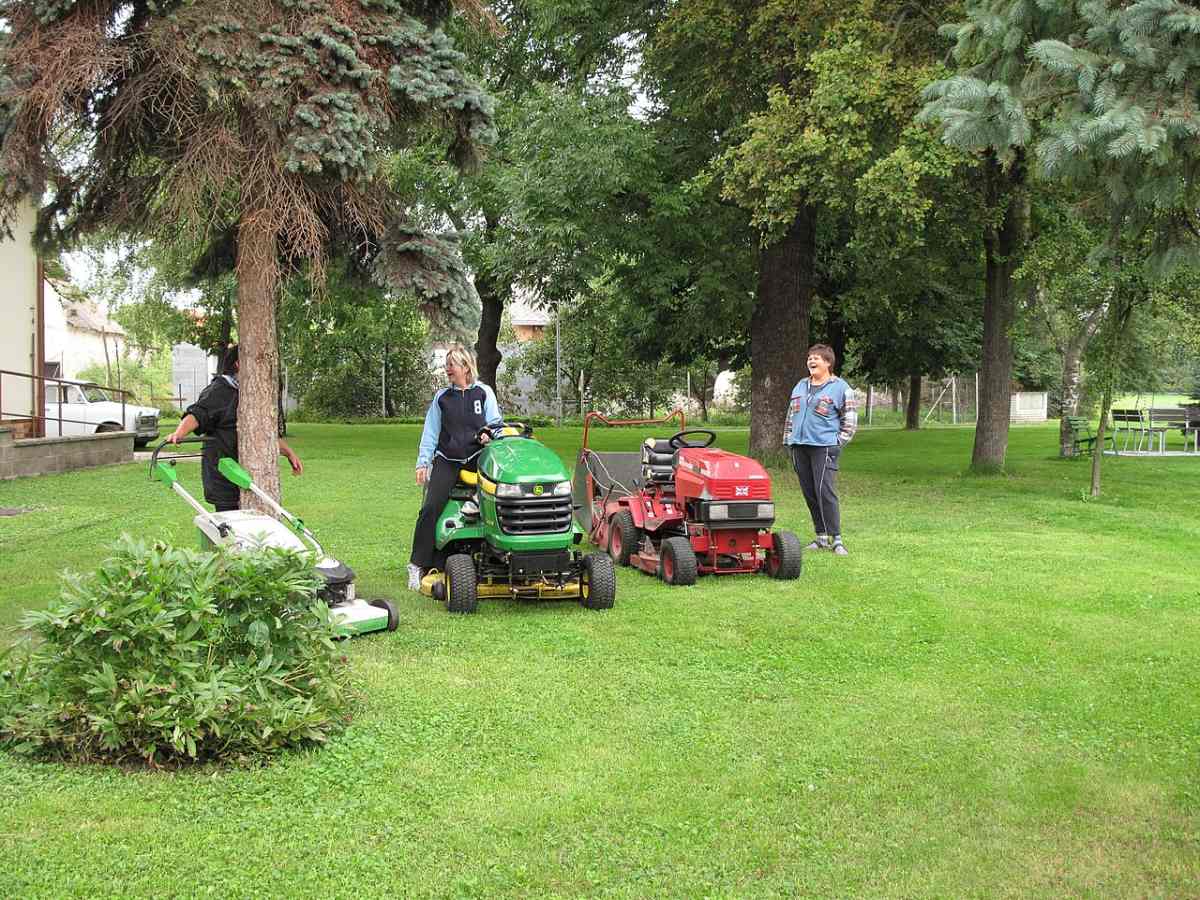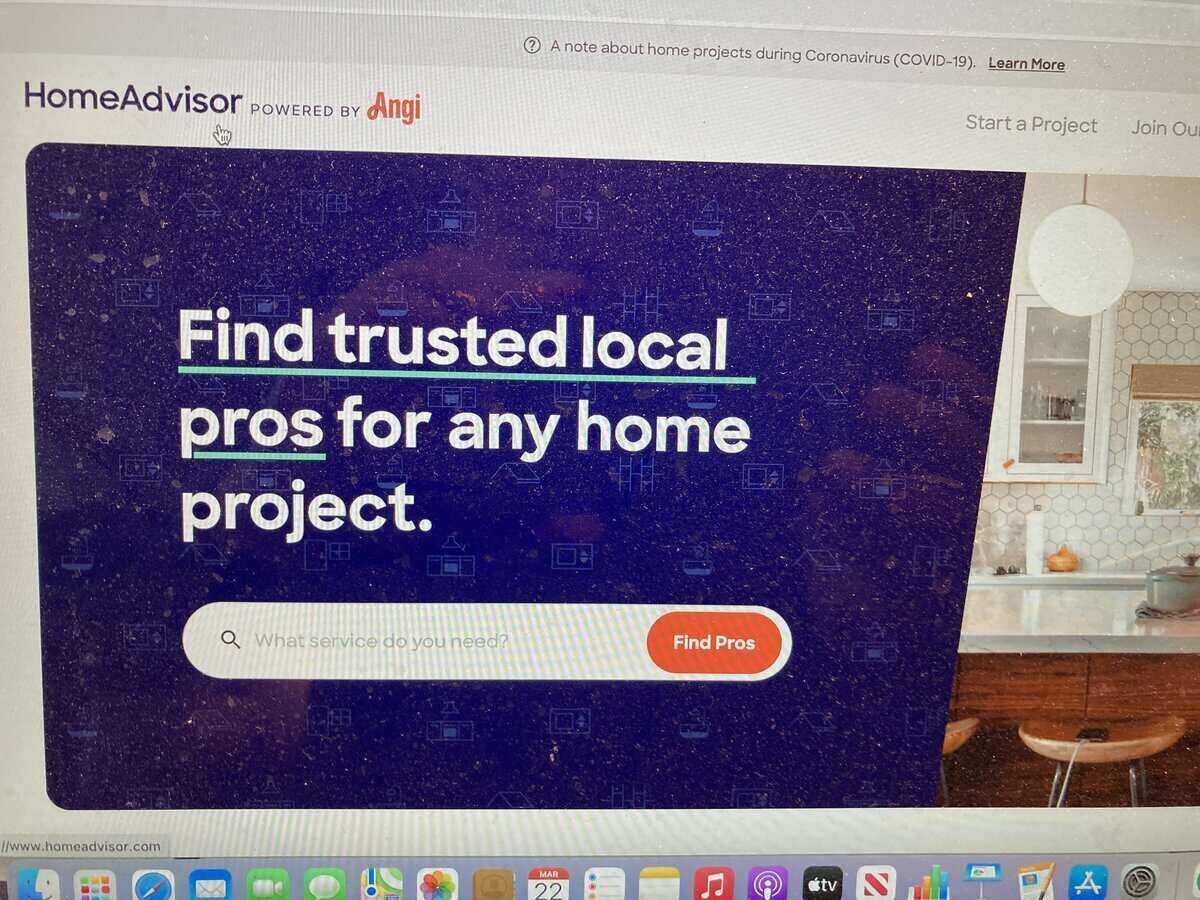
Record gas prices are hitting everyone hard, but for lawn care and outdoor services providers, it’s a one-two punch. Pros have to drive to their jobs and their mowers, leaf blowers, trimmers, chainsaws, and other equipment are usually gas-powered.
How big of an impact are rising gas prices having on outdoor services providers?
“I used to fill up my gas tank for under $80 a year ago. Now I’m around $140, depending on the gas station,” says LawnStarter pro Jesse Nunez, owner of Clean Cut Land in Englewood, Colorado.
Now, multiply that price increase by 55, the number of trucks Diamond Landscapes fuels up once a week to serve its customers across Lexington and Jeffersontown, Kentucky. “It’s the elephant in the room. It’s something we have to have,” Diamond Landscapes President Chris Trower told WTVQ.
The average cost per gallon hit a record $4.52 across the U.S. on May 17, and the average price of gas topped $4 for the first time in each of the 50 states on May 19, AAA says. Some expect prices could hit $7 a gallon in coming weeks.
How are outdoor services providers dealing with the pain at the pump? What tips do they have for dealing with rising prices at gas stations, grocery stores, and everywhere else? What are some ways all of us can cut our fuel costs a bit?
We’ll cover all of that in this article.
Table of Contents
- Gas Prices by City
- How Outdoor Service Providers Are Dealing with Gas Prices
- Ask the Experts
- How Everyone Can Save on Gas Prices Now
Highest Gas Prices and Percentage Increases in 200 Largest U.S. Cities
We ranked the 200 biggest U.S. cities from most impacted (No. 1) to least impacted (No. 200) based on their overall scores (out of 100 possible points), averaged across all the weighted metrics displayed in the table below. Weights were distributed as follows: Average Regular Price on May 17: 4, One-Week Change Up to May 17: 3; One-Month Change Up to May 17 and One-Year Change Up to May 17: 2; and Vs. National Average on May 17: 1. We collected the average regular gas price for both the nation and each metro area from AAA on May 17, 2022.
| Overall Rank (1=Most Impacted) | City | Overall Score | Average Regular Price on May 17 | One-Week Change Up to May 17 | One-Month Change Up to May 17 | One-Year Change Up to May 17 | Vs. National Average on May 17 |
|---|---|---|---|---|---|---|---|
| 1 | San Francisco, CA | 69.83 | $6.25 | 3.39% | 7.71% | 47.08% | 38.23% |
| 1 | Fremont, CA | 69.83 | $6.25 | 3.39% | 7.71% | 47.08% | 38.23% |
| 1 | Hayward, CA | 69.83 | $6.25 | 3.39% | 7.71% | 47.08% | 38.23% |
| 4 | Santa Rosa, CA | 69.08 | $6.22 | 3.49% | 7.80% | 46.01% | 37.61% |
| 5 | Oakland, CA | 67.85 | $6.13 | 3.72% | 6.98% | 46.30% | 35.62% |
| 6 | Sacramento, CA | 67.31 | $6.01 | 3.80% | 8.29% | 46.94% | 32.96% |
| 6 | Elk Grove, CA | 67.31 | $6.01 | 3.80% | 8.29% | 46.94% | 32.96% |
| 8 | San Jose, CA | 66.60 | $6.12 | 3.27% | 7.33% | 46.68% | 35.49% |
| 8 | Sunnyvale, CA | 66.60 | $6.12 | 3.27% | 7.33% | 46.68% | 35.49% |
| 10 | Orange, CA | 65.29 | $6.05 | 3.77% | 5.03% | 46.49% | 33.85% |
| 11 | Stockton, CA | 64.99 | $5.94 | 3.66% | 7.41% | 47.03% | 31.42% |
| 12 | Salinas, CA | 64.91 | $6.11 | 2.86% | 7.38% | 46.52% | 35.18% |
| 13 | Glendale, AZ | 64.79 | $5.02 | 5.75% | 9.82% | 59.08% | 11.11% |
| 14 | Springfield, MA | 64.76 | $4.61 | 5.91% | 17.70% | 60.84% | 1.95% |
| 15 | Anchorage, AK | 63.13 | $5.02 | 6.10% | 8.37% | 56.02% | 11.15% |
| 16 | Fresno, CA | 62.94 | $5.86 | 3.90% | 6.74% | 45.41% | 29.65% |
| 17 | Peoria, AZ | 61.82 | $5.00 | 5.53% | 8.95% | 57.07% | 10.64% |
| 17 | Los Angeles, CA | 61.82 | $6.07 | 2.99% | 4.48% | 45.33% | 34.20% |
| 17 | Long Beach, CA | 61.82 | $6.07 | 2.99% | 4.48% | 45.33% | 34.20% |
| 17 | Anaheim, CA | 61.82 | $6.07 | 2.99% | 4.48% | 45.33% | 34.20% |
| 17 | Santa Ana, CA | 61.82 | $6.07 | 2.99% | 4.48% | 45.33% | 34.20% |
| 17 | Irvine, CA | 61.82 | $6.07 | 2.99% | 4.48% | 45.33% | 34.20% |
| 17 | Santa Clarita, CA | 61.82 | $6.07 | 2.99% | 4.48% | 45.33% | 34.20% |
| 17 | Huntington Beach, CA | 61.82 | $6.07 | 2.99% | 4.48% | 45.33% | 34.20% |
| 17 | Glendale, CA | 61.82 | $6.07 | 2.99% | 4.48% | 45.33% | 34.20% |
| 17 | Garden Grove, CA | 61.82 | $6.07 | 2.99% | 4.48% | 45.33% | 34.20% |
| 17 | Lancaster, CA | 61.82 | $6.07 | 2.99% | 4.48% | 45.33% | 34.20% |
| 17 | Palmdale, CA | 61.82 | $6.07 | 2.99% | 4.48% | 45.33% | 34.20% |
| 17 | Pomona, CA | 61.82 | $6.07 | 2.99% | 4.48% | 45.33% | 34.20% |
| 17 | Torrance, CA | 61.82 | $6.07 | 2.99% | 4.48% | 45.33% | 34.20% |
| 17 | Pasadena, CA | 61.82 | $6.07 | 2.99% | 4.48% | 45.33% | 34.20% |
| 17 | Fullerton, CA | 61.82 | $6.07 | 2.99% | 4.48% | 45.33% | 34.20% |
| 33 | Modesto, CA | 61.25 | $5.80 | 3.57% | 7.81% | 45.00% | 28.32% |
| 34 | Rockford, IL | 60.60 | $4.80 | 5.96% | 14.01% | 52.38% | 6.19% |
| 35 | Worcester, MA | 60.54 | $4.64 | 5.29% | 13.90% | 61.12% | 2.59% |
| 36 | Tampa, FL | 60.06 | $4.51 | 6.37% | 13.60% | 58.25% | -0.22% |
| 36 | St. Petersburg, FL | 60.06 | $4.51 | 6.37% | 13.60% | 58.25% | -0.22% |
| 38 | Phoenix, AZ | 59.97 | $4.99 | 5.07% | 8.33% | 57.69% | 10.49% |
| 38 | Mesa, AZ | 59.97 | $4.99 | 5.07% | 8.33% | 57.69% | 10.49% |
| 38 | Chandler, AZ | 59.97 | $4.99 | 5.07% | 8.33% | 57.69% | 10.49% |
| 38 | Gilbert, AZ | 59.97 | $4.99 | 5.07% | 8.33% | 57.69% | 10.49% |
| 38 | Tempe, AZ | 59.97 | $4.99 | 5.07% | 8.33% | 57.69% | 10.49% |
| 43 | Boston, MA | 59.41 | $4.67 | 5.01% | 14.03% | 59.78% | 3.36% |
| 44 | Riverside, CA | 58.40 | $5.96 | 2.64% | 3.83% | 45.72% | 31.79% |
| 44 | Fontana, CA | 58.40 | $5.96 | 2.64% | 3.83% | 45.72% | 31.79% |
| 44 | Moreno Valley, CA | 58.40 | $5.96 | 2.64% | 3.83% | 45.72% | 31.79% |
| 44 | Ontario, CA | 58.40 | $5.96 | 2.64% | 3.83% | 45.72% | 31.79% |
| 44 | Rancho Cucamonga, CA | 58.40 | $5.96 | 2.64% | 3.83% | 45.72% | 31.79% |
| 44 | Corona, CA | 58.40 | $5.96 | 2.64% | 3.83% | 45.72% | 31.79% |
| 50 | San Diego, CA | 58.10 | $6.00 | 2.55% | 3.97% | 44.37% | 32.68% |
| 50 | Chula Vista, CA | 58.10 | $6.00 | 2.55% | 3.97% | 44.37% | 32.68% |
| 50 | Oceanside, CA | 58.10 | $6.00 | 2.55% | 3.97% | 44.37% | 32.68% |
| 50 | Escondido, CA | 58.10 | $6.00 | 2.55% | 3.97% | 44.37% | 32.68% |
| 54 | New York, NY | 57.89 | $4.75 | 5.77% | 13.27% | 51.37% | 5.02% |
| 54 | Jersey City, NJ | 57.89 | $4.75 | 5.77% | 13.27% | 51.37% | 5.02% |
| 54 | Yonkers, NY | 57.89 | $4.75 | 5.77% | 13.27% | 51.37% | 5.02% |
| 57 | Jacksonville, FL | 57.15 | $4.49 | 5.65% | 13.67% | 58.10% | -0.66% |
| 58 | Vancouver, WA | 56.95 | $5.10 | 5.09% | 8.94% | 48.50% | 12.92% |
| 59 | Oxnard, CA | 56.83 | $5.86 | 2.63% | 5.02% | 44.69% | 29.65% |
| 60 | Orlando, FL | 56.70 | $4.49 | 5.40% | 14.25% | 58.10% | -0.66% |
| 61 | San Bernardino, CA | 56.64 | $5.96 | 2.50% | 3.17% | 44.40% | 31.75% |
| 62 | Tacoma, WA | 55.75 | $5.18 | 5.18% | 9.43% | 43.03% | 14.49% |
| 63 | Rochester, NY | 55.49 | $4.61 | 6.34% | 7.60% | 55.04% | 2.08% |
| 64 | Indianapolis, IN | 55.16 | $4.51 | 4.88% | 17.14% | 54.45% | -0.22% |
| 65 | Chicago, IL | 55.15 | $5.29 | 3.32% | 10.90% | 47.77% | 17.04% |
| 66 | Cape Coral, FL | 55.00 | $4.48 | 5.41% | 12.85% | 57.19% | -0.88% |
| 67 | Grand Rapids, MI | 54.51 | $4.51 | 3.97% | 18.20% | 57.40% | -0.27% |
| 67 | Syracuse, NY | 54.51 | $4.60 | 5.96% | 8.49% | 54.86% | 1.79% |
| 69 | Bakersfield, CA | 54.12 | $5.93 | 1.66% | 2.36% | 46.92% | 31.28% |
| 70 | Buffalo, NY | 53.93 | $4.55 | 6.49% | 6.54% | 54.70% | 0.55% |
| 71 | Bridgeport, CT | 53.71 | $4.64 | 4.98% | 16.58% | 48.24% | 2.65% |
| 72 | Akron, OH | 53.52 | $4.40 | 5.01% | 17.02% | 54.39% | -2.65% |
| 73 | Washington, DC | 53.18 | $4.86 | 3.18% | 14.08% | 54.29% | 7.52% |
| 74 | Port St. Lucie, FL | 53.07 | $4.53 | 4.86% | 12.41% | 56.21% | 0.22% |
| 75 | Seattle, WA | 52.97 | $5.22 | 4.71% | 7.71% | 41.96% | 15.58% |
| 75 | Bellevue, WA | 52.97 | $5.22 | 4.71% | 7.71% | 41.96% | 15.58% |
| 77 | Fort Wayne, IN | 52.82 | $4.48 | 4.19% | 18.83% | 53.42% | -0.88% |
| 78 | Fort Lauderdale, FL | 52.41 | $4.56 | 4.83% | 10.95% | 56.16% | 0.88% |
| 79 | Dayton, OH | 51.76 | $4.36 | 4.56% | 19.78% | 51.92% | -3.54% |
| 80 | Scottsdale, AZ | 51.31 | $5.00 | 3.24% | 7.04% | 55.15% | 10.66% |
| 80 | St. Louis, MO | 51.31 | $4.27 | 6.12% | 12.77% | 53.29% | -5.62% |
| 82 | Miami, FL | 51.23 | $4.54 | 4.61% | 11.00% | 56.01% | 0.44% |
| 82 | Hialeah, FL | 51.23 | $4.54 | 4.61% | 11.00% | 56.01% | 0.44% |
| 82 | Pembroke Pines, FL | 51.23 | $4.54 | 4.61% | 11.00% | 56.01% | 0.44% |
| 82 | Hollywood, FL | 51.23 | $4.54 | 4.61% | 11.00% | 56.01% | 0.44% |
| 82 | Miramar, FL | 51.23 | $4.54 | 4.61% | 11.00% | 56.01% | 0.44% |
| 87 | Cincinnati, OH | 50.41 | $4.37 | 5.30% | 14.70% | 51.21% | -3.32% |
| 88 | Aurora, IL | 50.32 | $5.03 | 2.65% | 12.28% | 49.70% | 11.28% |
| 88 | Joliet, IL | 50.32 | $5.03 | 2.65% | 12.28% | 49.70% | 11.28% |
| 88 | Naperville, IL | 50.32 | $5.03 | 2.65% | 12.28% | 49.70% | 11.28% |
| 91 | Cleveland, OH | 47.86 | $4.39 | 4.52% | 13.44% | 52.43% | -2.88% |
| 92 | Providence, RI | 47.74 | $4.44 | 4.77% | 10.70% | 52.60% | -1.79% |
| 93 | Spokane, WA | 47.44 | $4.77 | 3.67% | 11.99% | 47.06% | 5.58% |
| 94 | Philadelphia, PA | 47.36 | $4.66 | 3.76% | 11.80% | 49.92% | 3.12% |
| 95 | Winston-Salem, NC | 47.23 | $4.21 | 6.64% | 10.89% | 47.51% | -6.92% |
| 96 | Reno, NV | 46.84 | $5.31 | 2.61% | 4.57% | 45.09% | 17.46% |
| 97 | Detroit, MI | 46.47 | $4.52 | 3.67% | 13.85% | 50.67% | 0.00% |
| 98 | Tallahassee, FL | 46.35 | $4.47 | 4.44% | 12.59% | 49.00% | -1.11% |
| 99 | Salem, OR | 45.55 | $4.80 | 4.14% | 6.33% | 47.12% | 6.24% |
| 100 | Houston, TX | 45.50 | $4.22 | 4.05% | 12.15% | 57.88% | -6.70% |
| 100 | Pasadena, TX | 45.50 | $4.22 | 4.05% | 12.15% | 57.88% | -6.70% |
| 102 | Raleigh, NC | 44.70 | $4.22 | 5.96% | 10.42% | 47.52% | -6.73% |
| 102 | Cary, NC | 44.70 | $4.22 | 5.96% | 10.42% | 47.52% | -6.73% |
| 104 | El Paso, TX | 44.60 | $4.29 | 4.58% | 13.71% | 49.29% | -5.11% |
| 105 | Newark, NJ | 44.59 | $4.52 | 4.53% | 9.60% | 47.68% | -0.02% |
| 105 | Paterson, NJ | 44.59 | $4.52 | 4.53% | 9.60% | 47.68% | -0.02% |
| 107 | Albuquerque, NM | 44.58 | $4.28 | 5.94% | 8.24% | 48.25% | -5.31% |
| 108 | Fayetteville, NC | 44.44 | $4.19 | 6.06% | 10.89% | 46.83% | -7.39% |
| 109 | Chattanooga, TN | 44.34 | $4.10 | 6.16% | 7.05% | 53.39% | -9.29% |
| 110 | Milwaukee, WI | 44.23 | $4.42 | 3.03% | 14.64% | 52.66% | -2.12% |
| 111 | Toledo, OH | 44.19 | $4.35 | 3.57% | 15.08% | 51.04% | -3.76% |
| 112 | Columbus, OH | 44.14 | $4.33 | 3.59% | 16.40% | 49.83% | -4.20% |
| 113 | San Antonio, TX | 43.74 | $4.14 | 3.71% | 16.25% | 54.32% | -8.36% |
| 114 | Greensboro, NC | 43.43 | $4.19 | 5.88% | 10.08% | 47.12% | -7.23% |
| 115 | Dallas, TX | 43.22 | $4.30 | 3.74% | 15.25% | 49.72% | -4.87% |
| 115 | Plano, TX | 43.22 | $4.30 | 3.74% | 15.25% | 49.72% | -4.87% |
| 115 | Irving, TX | 43.22 | $4.30 | 3.74% | 15.25% | 49.72% | -4.87% |
| 115 | Garland, TX | 43.22 | $4.30 | 3.74% | 15.25% | 49.72% | -4.87% |
| 115 | Grand Prairie, TX | 43.22 | $4.30 | 3.74% | 15.25% | 49.72% | -4.87% |
| 115 | McKinney, TX | 43.22 | $4.30 | 3.74% | 15.25% | 49.72% | -4.87% |
| 115 | Frisco, TX | 43.22 | $4.30 | 3.74% | 15.25% | 49.72% | -4.87% |
| 115 | Mesquite, TX | 43.22 | $4.30 | 3.74% | 15.25% | 49.72% | -4.87% |
| 123 | Austin, TX | 42.93 | $4.20 | 3.45% | 13.98% | 55.44% | -7.08% |
| 124 | Portland, OR | 42.28 | $4.95 | 2.89% | 4.47% | 46.70% | 9.60% |
| 125 | Fort Worth, TX | 42.10 | $4.29 | 3.55% | 15.32% | 49.17% | -5.09% |
| 125 | Arlington, TX | 42.10 | $4.29 | 3.55% | 15.32% | 49.17% | -5.09% |
| 127 | Baltimore, MD | 42.07 | $4.48 | 1.54% | 22.10% | 46.96% | -1.00% |
| 128 | Montgomery, AL | 41.82 | $4.27 | 4.66% | 11.18% | 47.87% | -5.62% |
| 129 | Corpus Christi, TX | 41.29 | $4.13 | 3.14% | 17.21% | 52.68% | -8.56% |
| 130 | Killeen, TX | 41.12 | $4.16 | 3.28% | 14.06% | 54.51% | -7.94% |
| 131 | Laredo, TX | 41.02 | $4.13 | 3.09% | 17.42% | 52.27% | -8.61% |
| 132 | Eugene, OR | 40.57 | $4.85 | 3.04% | 4.59% | 45.82% | 7.37% |
| 133 | Clarksville, TN | 40.27 | $4.13 | 4.98% | 8.43% | 50.90% | -8.63% |
| 134 | Durham, NC | 40.08 | $4.21 | 5.57% | 7.27% | 46.18% | -6.92% |
| 135 | Arlington, VA | 39.56 | $4.50 | 2.72% | 10.81% | 48.94% | -0.42% |
| 135 | Alexandria, VA | 39.56 | $4.50 | 2.72% | 10.81% | 48.94% | -0.42% |
| 137 | Louisville, KY | 39.46 | $4.37 | 4.45% | 9.53% | 44.14% | -3.34% |
| 138 | Memphis, TN | 39.18 | $4.18 | 4.95% | 6.26% | 50.41% | -7.59% |
| 139 | Madison, WI | 38.80 | $4.25 | 3.01% | 13.58% | 50.11% | -6.02% |
| 140 | McAllen, TX | 38.76 | $4.11 | 3.21% | 17.17% | 48.68% | -8.98% |
| 141 | Shreveport, LA | 37.92 | $4.19 | 3.56% | 10.09% | 51.46% | -7.35% |
| 142 | Baton Rouge, LA | 37.67 | $4.16 | 3.61% | 8.16% | 53.96% | -7.90% |
| 143 | Birmingham, AL | 37.36 | $4.22 | 3.74% | 10.39% | 48.21% | -6.68% |
| 144 | Mobile, AL | 37.04 | $4.24 | 3.49% | 9.69% | 49.35% | -6.13% |
| 145 | New Orleans, LA | 36.93 | $4.19 | 3.46% | 6.38% | 54.88% | -7.35% |
| 145 | Metairie, LA | 36.93 | $4.19 | 3.46% | 6.38% | 54.88% | -7.35% |
| 147 | Huntsville, AL | 36.32 | $4.23 | 3.32% | 10.62% | 48.33% | -6.44% |
| 148 | Brownsville, TX | 36.15 | $4.10 | 3.02% | 15.63% | 47.62% | -9.34% |
| 149 | Charlotte, NC | 35.91 | $4.18 | 4.34% | 7.87% | 46.53% | -7.54% |
| 150 | Columbus, GA | 35.82 | $4.05 | 4.38% | 14.41% | 42.11% | -10.40% |
| 151 | Knoxville, TN | 35.77 | $4.15 | 4.33% | 3.91% | 52.07% | -8.25% |
| 152 | Lexington, KY | 35.75 | $4.26 | 3.02% | 10.05% | 48.93% | -5.80% |
| 153 | Sioux Falls, SD | 34.81 | $4.15 | 4.08% | 10.71% | 43.64% | -8.10% |
| 154 | Honolulu, HI | 32.70 | $5.23 | 0.77% | 1.75% | 37.99% | 15.71% |
| 155 | Nashville, TN | 31.52 | $4.25 | 2.38% | 10.84% | 44.89% | -5.88% |
| 155 | Murfreesboro, TN | 31.52 | $4.25 | 2.38% | 10.84% | 44.89% | -5.88% |
| 157 | Little Rock, AR | 31.01 | $4.04 | 2.96% | 9.68% | 48.40% | -10.73% |
| 158 | Amarillo, TX | 30.90 | $3.98 | 2.29% | 10.37% | 53.04% | -11.90% |
| 159 | Omaha, NE | 30.56 | $4.08 | 4.16% | 8.92% | 40.36% | -9.76% |
| 160 | Pittsburgh, PA | 30.47 | $4.47 | 2.20% | 5.80% | 43.76% | -1.15% |
| 161 | Virginia Beach, VA | 30.21 | $4.31 | 1.13% | 10.15% | 49.08% | -4.71% |
| 161 | Norfolk, VA | 30.21 | $4.31 | 1.13% | 10.15% | 49.08% | -4.71% |
| 161 | Chesapeake, VA | 30.21 | $4.31 | 1.13% | 10.15% | 49.08% | -4.71% |
| 161 | Newport News, VA | 30.21 | $4.31 | 1.13% | 10.15% | 49.08% | -4.71% |
| 161 | Augusta, GA | 30.21 | $4.07 | 4.09% | 10.60% | 38.44% | -9.96% |
| 166 | Lubbock, TX | 30.16 | $3.99 | 2.39% | 12.39% | 48.49% | -11.73% |
| 167 | Macon, GA | 29.15 | $4.06 | 4.10% | 8.85% | 39.04% | -10.18% |
| 168 | Savannah, GA | 28.88 | $4.06 | 3.57% | 10.63% | 39.52% | -10.18% |
| 169 | Jackson, MS | 28.69 | $3.98 | 3.84% | 5.18% | 46.63% | -11.99% |
| 170 | Tucson, AZ | 28.48 | $4.49 | 1.15% | 2.60% | 49.80% | -0.58% |
| 171 | Richmond, VA | 28.13 | $4.30 | 1.27% | 9.83% | 45.45% | -4.85% |
| 172 | Des Moines, IA | 28.01 | $4.19 | 1.70% | 12.33% | 43.00% | -7.30% |
| 173 | Las Vegas, NV | 27.80 | $5.13 | -0.49% | -0.89% | 43.36% | 13.38% |
| 173 | Henderson, NV | 27.80 | $5.13 | -0.49% | -0.89% | 43.36% | 13.38% |
| 173 | North Las Vegas, NV | 27.80 | $5.13 | -0.49% | -0.89% | 43.36% | 13.38% |
| 173 | Paradise, NV | 27.80 | $5.13 | -0.49% | -0.89% | 43.36% | 13.38% |
| 173 | Spring Valley, NV | 27.80 | $5.13 | -0.49% | -0.89% | 43.36% | 13.38% |
| 173 | Sunrise Manor, NV | 27.80 | $5.13 | -0.49% | -0.89% | 43.36% | 13.38% |
| 173 | Enterprise, NV | 27.80 | $5.13 | -0.49% | -0.89% | 43.36% | 13.38% |
| 180 | Lincoln, NE | 27.46 | $4.13 | 3.02% | 7.45% | 42.14% | -8.74% |
| 181 | Midland, TX | 26.65 | $4.18 | 2.13% | 10.53% | 40.72% | -7.57% |
| 182 | Atlanta, GA | 26.30 | $4.07 | 4.09% | 8.24% | 34.77% | -9.96% |
| 183 | Salt Lake City, UT | 24.37 | $4.56 | 2.17% | 2.36% | 35.22% | 0.82% |
| 184 | Kansas City, MO | 23.70 | $3.92 | 2.22% | 10.95% | 42.51% | -13.23% |
| 185 | Tulsa, OK | 23.23 | $3.96 | 2.51% | 11.62% | 38.04% | -12.41% |
| 186 | Springfield, MO | 22.14 | $3.96 | 1.15% | 12.27% | 43.34% | -12.35% |
| 187 | Overland Park, KS | 21.35 | $3.97 | 1.79% | 11.20% | 39.30% | -12.17% |
| 187 | Kansas City, KS | 21.35 | $3.97 | 1.79% | 11.20% | 39.30% | -12.17% |
| 187 | Olathe, KS | 21.35 | $3.97 | 1.79% | 11.20% | 39.30% | -12.17% |
| 190 | Minneapolis, MN | 18.54 | $4.11 | 0.34% | 6.51% | 44.56% | -9.14% |
| 190 | St. Paul, MN | 18.54 | $4.11 | 0.34% | 6.51% | 44.56% | -9.14% |
| 192 | Oklahoma City, OK | 17.85 | $4.02 | 0.42% | 5.95% | 46.27% | -10.97% |
| 193 | Boise, ID | 17.46 | $4.55 | 0.44% | 0.89% | 35.82% | 0.66% |
| 194 | Fort Collins, CO | 14.30 | $4.11 | 0.79% | 5.17% | 36.48% | -9.12% |
| 195 | Colorado Springs, CO | 13.06 | $4.11 | 0.93% | 5.44% | 33.27% | -9.16% |
| 196 | Wichita, KS | 12.13 | $3.96 | -0.53% | 11.22% | 37.71% | -12.50% |
| 197 | Denver, CO | 9.81 | $4.06 | 0.47% | 4.21% | 33.49% | -10.22% |
| 197 | Aurora, CO | 9.81 | $4.06 | 0.47% | 4.21% | 33.49% | -10.22% |
| 197 | Lakewood, CO | 9.81 | $4.06 | 0.47% | 4.21% | 33.49% | -10.22% |
| 197 | Thornton, CO | 9.81 | $4.06 | 0.47% | 4.21% | 33.49% | -10.22% |
How Outdoor Services Providers Are Dealing with Gas Prices
Clustering jobs saves time and gas. Route optimization tools, built into LawnStarter’s pro app (and similar services’ apps), help lawn care pros to get more work done using less fuel. Shorter trips from job to job cut down on fill-ups.
LawnStarter pro Justin Stultz in Hutto, Texas, has had to raise prices for some customers to cover his higher fuel costs. He also is making fewer trips for jobs in North Austin because it just costs more in gas to get there.
LawnStarter also raised the cost for lawn care service for many customers April 8 to cover the higher fuel costs and soaring inflation. The price bump increases payouts to pros to help with their pain at the pump.
Uber and Lyft are among other companies that have raised prices in recent weeks to cope with climbing fuel costs.
How long will this last and what can lawn care pros – and all of us – do to cut our fuel expenses and maybe reduce trips to the gas station? We asked four economists for their insights and predictions.
Ask the Experts
Tyler Ransom – Assistant Professor of Economics, University of Oklahoma
 When do you expect gas prices to peak in the U.S.? What will it take to get gas prices under control?
When do you expect gas prices to peak in the U.S.? What will it take to get gas prices under control?
I expect gas prices to peak before the end of 2022, but to continue to rise into the summer. The cause of the most recent spike seems to be the conflict in the Ukraine. If and when that conflict resolves, I expect the price to come back down.
What less obvious short- and long-term effects, if any, will higher gas prices have on the outdoor services industry?
Outdoor services will have a difficult choice to make this spring: raise their prices (to pass the cost of gas on to their customers) or take a hit out of their bottom line. I don’t see many long-term effects from this current spike.
How likely is this development to accelerate the lawn care industry’s transition to greener practices and equipment?
I don’t see electric tools as a long-term solution for the lawn care industry. Not unless the battery technology improves substantially. Otherwise, lawn servicers will have to buy twice the equipment so that half of it can be charging at any given time. It’s not feasible with the current technology, so I don’t see the current gas price spike as affecting that adoption decision.
What are three tips to cut fuel costs that you would offer to lawn care pros and everyone else feeling financial pain at the pump when filling up?
- The obvious solution is to not consume as much fuel!
- For lawn servicers, that means going longer in between appointments to reduce total machine usage.
- Always fill up at the same gas station chain to take advantage of any rewards programs for customer loyalty.
Thomas Drennen – Professor of Economics and Environmental Studies, Hobart and William Smith Colleges
 When do you expect gas prices to peak in the U.S.? What will it take to get gas prices under control?
When do you expect gas prices to peak in the U.S.? What will it take to get gas prices under control?
First, we’ve seen this story before. Oil prices peaked above $140/barrel in July 2008. At the time, many said that oil prices would hit $200/bbl and that this was the new normal. By December, they were at $33/bbl. Oil prices are set by the markets – not by individual companies or countries. When prices rise, new/additional production comes online. At the same time, demand starts falling as consumers respond to the higher prices. So here’s what we know and don’t know:
* Gas prices are likely to remain extremely volatile for the next few months, but will eventually come down as production ramps up worldwide as available suppliers as higher oil prices lead more producers to increase production and to invest in new sources. For example, Saudi Aramco recently announced they’d invest $50 billion this year on projects, including shale drilling.
* Whether or not prices have peaked is unknown, largely because no one knows what the outcome of the Russia/Ukraine conflict will be. It’s clear that companies and countries intend to stop purchasing Russian oil. This is what’s driving prices up for now. It’s possible we’ll see them go higher if the conflict continues or if Russia takes additional steps toward retaliating for all the sanctions. So in the short term, we will have considerable supply uncertainty, which drives up prices. Countries can and will continue to respond to short-term supply disruptions by releasing oil from our strategic oil reserves, which were set up in the ‘70s for exactly this reason – to cushion any future supply interruptions.
* We learned during the 2008 run-up in gas prices that once gasoline goes over $4/gallon in the U.S., consumers begin changing their habits to avoid sticker shock at the pump. In 2008, we saw a huge dropoff in truck sales and huge increases in hybrid car sales, such as the Prius. This time around, we will see a sharp increase in EV sales and orders, including the electric Ford F-150. Apparently, Ford has to stop taking orders because demand was so high. We’ll also see a very steep uptick in electric mowers and accessories, such as leaf blowers/grass trimmers.
What are three tips to cut fuel costs that you would offer to lawn care pros and everyone else feeling financial pain at the pump when filling up?
In general, though, there’s not a lot that the lawn care service industry can do in the short term to offset the higher prices, other than to pass it along to consumers. Sure, they can make sure they don’t leave their trucks/equipment idling, can keep their driving speeds below 60 mph (vehicles more efficient at 60 than 75), keep tires properly inflated, etc., but this isn’t going to make a huge difference. And yes, gas prices will come down, but forward-looking companies should understand that the future is electric vehicles and equipment.
It’s likely many towns and states will start phasing out gasoline-powered lawn trimmers, mowers, etc., due to concerns about local air pollution and in general, a push to a lower-carbon future. Forward-looking companies should consider whether now is the time to make that switch. Consider the fact that Amazon has put in orders for 100,000 electric delivery vans – they are just one of many companies that see where things are going and want to be onboard sooner, rather than later. Companies should check out the availability of local, state, and federal incentives for purchasing electric vehicles or equipment as they might be surprised at how cost effective some of the options might be for them.
Linda M. Hooks – Professor of Economics and Head of the Economics Department, Washington and Lee University
 When do you expect gas prices to peak in the U.S.? What will it take to get gas prices under control?
When do you expect gas prices to peak in the U.S.? What will it take to get gas prices under control?
I expect that gas prices may be near their peak now. Some of this depends on the ongoing war in Ukraine and the U.S. ban on oil imported from Russia. Gas prices will return to levels more like the recent past when the war ends. However, gas prices are often volatile. For example, just two years ago, most of us noticed lower-than-usual gas prices when the pandemic began. Finally, gas prices are not at their all-time peak if you consider the purchasing power required to buy it, that is, the inflation-adjusted price. By that measure, we have had higher gas prices, although you would need to go back more than five years to find them.
What less obvious short- and long-term effects, if any, will higher gas prices have on the outdoor services industry?
Higher gas prices tend to make people take fewer road trips and stay home more. It sometimes also prompts people to work from home more. This is likely to lead to more interest in landscaping and in yard improvement projects. It also is likely to lead to more people wanting to find local spots to enjoy the outdoors, such as hiking and walking trails or local outdoor recreational sites like lakes, rivers, beaches, and camping sites.
The rise in gas prices is another nudge to consumers to find ways to use environmentally-friendly equipment and techniques. For those in the outdoor service industry, higher gas prices affect the everyday operations, such as the cost of fuel for equipment and for moving people and equipment, as well as encouraging a move toward processes that are less gas-dependent. Higher gas prices can also lead to an increased demand for lawn care services as people stay home.
How likely is this development to accelerate the lawn care industry’s transition to greener practices and equipment?
The rise in gas prices is a natural opportunity for the lawn care industry to promote a move to greener practices and equipment. If the rise in prices also affects homeowners’ interest in green practices, then the move could be substantial.
What are three tips to cut fuel costs that you would offer to lawn care pros and everyone else feeling financial pain at the pump when filling up?
My three basic tips are these: 1) avoid idling; 2) plan your jobs or trips to minimize driving; and 3) make sure you aren’t carrying excess items in your truck or car that might be adding to the vehicle weight.
Jonathan Ernest – Assistant Professor of Economics, Case Western Reserve University
 When do you expect gas prices to peak in the U.S.? What will it take to get gas prices under control?
When do you expect gas prices to peak in the U.S.? What will it take to get gas prices under control?
The price of gas is determined by a culmination of factors, on both the demand and supply sides of the market. In terms of supply, the reduction of imports of oil from Russia constitutes a negative shock to supply, which pushes prices higher. While higher prices for oil (which can be refined into gasoline) should elicit more domestic production, U.S. companies have struggled to immediately find the capital and labor necessary to produce and refine a higher quantity of a similar grade of oil domestically.
Coupled with this supply shock, we have also seen an increase in demand for gasoline. We see a seasonal increase each summer as people hit the open road when temperatures rise and holidays are taken, but it may also be impacted this year by people resuming more of their normal pre-Covid activities. In the short-run, demand likely increased even more as everyone rushed to the pump to purchase gas before the price rose further, driving prices even higher.
While there may be a large increase in demand overall, higher prices will still deter some drivers from taking extra trips or joyriding through the country, so we should see a stabilization of gas prices reasonably soon.
What less obvious short- and long-term effects, if any, will higher gas prices have on the outdoor services industry?
While the direct effect of higher gas prices may be using less gas by running your lawn mower or leaf blower less frequently, in the long-term people may find that the cost of switching to electric or manually powered tools doesn’t seem so bad, as long as gas prices remain high.
How likely is this development to accelerate the lawn care industry’s transition to greener practices and equipment?
When considering the switch from gas-powered equipment to greener tools, the benefits must be weighed against the costs. The benefits of not needing gasoline are much higher when that gasoline is expensive, but there are also benefits from having quieter and lighter tools that are easier to handle and require less maintenance.
The costs of using greener practices and equipment can be felt in terms of having less powerful tools, for instance. As the demand rises for these types of tools, it will push manufacturers to invest in development equipment that lasts longer and competes more evenly with the gas-powered alternatives, lowering these costs.
What are three tips to cut fuel costs that you would offer to lawn care pros and everyone else feeling financial pain at the pump when filling up?
1. Transportation to and from each lawn can eat up a lot of gas. Consider modernizing with transport vehicles that are more efficient, or reworking routes using logistics practices to minimize driving distance and overlap.
2. Consider the costs and benefits of electric tools and equipment.
3. While gas prices may not remain at their peak, or continue to rise, they likely won’t settle back to their recent lows anytime this season. If you’re a lawn care company, you may find that your competitors are raising rates to account for this extra cost. This is your opportunity to potentially raise rates to cover the cost of obtaining greener technology, or to cover the higher cost of fuel.
How Everyone Can Save on Gas Prices Now
Record gas prices will goose the cost of groceries, airline tickets, and all sorts of consumer products at small businesses and big-box stores. Short day trips likely will replace long summer road trips with the family.
How can all of us – lawn care pros and everyone else – save on gas prices now?
Fleet cards: Small businesses can save at every trip to the pump, and bigger small businesses save even more. There are a host of fleet card options, so check with your preferred gas station. Here are two examples of the possible savings.
- QuikTrip fleet cards: Save up to 5 cents per gallon with Fleetmaster and Fleetmaster Plus cards.
- Meijer Fleet Card: Save up to 5 cents per gallon at Meijer gas stations.
Warehouse club gas prices: Saving 5 or 10 cents a gallon quickly will cover your annual membership fee at Sam’s Club, Costco, and BJ’s.
Supermarket fuel perks: Your everyday spending at the supermarket adds up to cents off per gallon at select gas stations. Check with your favorite grocery if it’s not listed below.
- Albertsons and Safeway store rewards will save you 10 cents a gallon.
- A Meijer credit card will save you 10 cents a gallon at Meijer gas stations.
- With Kroger’s Fuel Points program, you earn 1 fuel point for every dollar you spend.
Shell Fuel Rewards: Save 5 cents a gallon at Shell stations.
Switch to battery-powered or electric mowers, trimmers, and blowers: Look for sales online ahead of Father’s Day, Prime Day, Black Friday, and spring. Check manufacturer websites, Amazon, Home Depot, Lowe’s, Walmart, and other store websites. And if you’re a lawn care pro or homeowner in California, check for county or city incentives to help lower the cost of making the switch to eco-friendly lawn care equipment.
Bonus savings? Some shopping portals affiliated with credit cards or airlines will save you an extra 5%-10% on lawn care equipment.
Plan/group your shopping trips: Get all you can in one trip out and group your stops close together to save on gas. LawnStarter’s app does this for pros, but you can do this too if you plan ahead.
Cross state lines: If you live in a city bordering another state and the prices are lower on the other side of the river or a stone’s throw away, shop across state lines. Make the trip to save, but you may have to wait as it’s likely many others had the same great idea.
Walk/Bicycle/Mass Transit: Leave your car in the driveway or parking garage and use your feet or pedal your way to the CVS or Walgreens. Or take a bus, subway, or train to get to work or watch your favorite team play. You’ll see more walking – everything is in bloom, and you’ll likely be surrounded by like-minded fans to and from the game.
If you have a fuel savings tip you’d like to share, email [email protected]. If you want to help your LawnStarter pro with higher fuel costs, you can tip him or her for a job well done.
Main Photo Credit: Jeff Herman with text overlay




